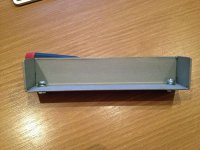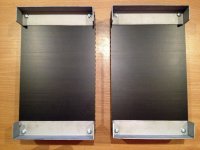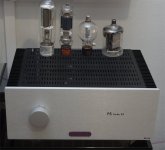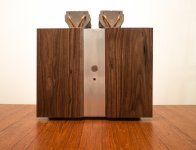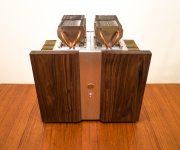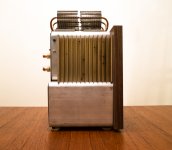Agree on Nexus fans. I have them in my HTPC, and they are really silent. No need for fanless PC's with good silent fans.
Sure, just fit the biggest heatsink you can find, a pair of 12cm fans running at 20-30% their rated speed isolated from chassis with rubber gomets, isolate mechanicals hard drives from the case, and you won't hear it. Sorry for the OT.
reg, not sure that's OT because those are the techniques that are necessary if one adopts liquid cooling for power amps. The physical isolation is key for use with audio. What are you using to regulate the fan speed?
Walter, nice build. What is the purpose of the caps which are mounted on the diyaudio f5 board. Is there are reason they are put there and where do you install them, (before the _+ - voltage in? Does this help the sound quality? I am wondering if I should put some on mine also. thanks, John
One of these controllers, they are just potentiometers acting as a voltage divider (no active devices involved) AFAIR. I got it for something like 10€ and fits in a 3.5" bay. Nice blue leds and overall finish. I currently have it disassembled due to a new computer I am building, so would you like me to draw down the schematic, resistor values and so?reg, not sure that's OT because those are the techniques that are necessary if one adopts liquid cooling for power amps. The physical isolation is key for use with audio. What are you using to regulate the fan speed?
http://i01.i.aliimg.com/wsphoto/v0/...r-PC-3-5-Floppy-Bay-with-4-Fan-Controller.jpg
It is VERY important to fit the fans with those grommets, so vibrations will not be transferred to the enclosure. Even at 100% full speed, if properly isolated, a Nexus fan will be pretty much silent inside a case.
http://reviewstash.com/files/NF-P14FLX/fanmount.jpg
Hi together,
finished my Pass Aleph mini .... little 14 kg weight! 😀
Regards ............Carsten
finished my Pass Aleph mini .... little 14 kg weight! 😀
An externally hosted image should be here but it was not working when we last tested it.
An externally hosted image should be here but it was not working when we last tested it.
An externally hosted image should be here but it was not working when we last tested it.
An externally hosted image should be here but it was not working when we last tested it.
Regards ............Carsten
Hi John,
I got a hint from an other DIY that putting a little 'audio grade' capacitor will give it a better sound, details in the highs and so... because my large Panasonic capacitorbank is computergrade...
I don't know if it really matters, I can't hear the difference.😕
But it is common here, to put a large polypropyleen capacitor ( 4u7 - 10 uF) over a big capacitorbank.
You can put some on the F5 board, but you've got to improvise with big wires underneath the board.
Walter
I got a hint from an other DIY that putting a little 'audio grade' capacitor will give it a better sound, details in the highs and so... because my large Panasonic capacitorbank is computergrade...
I don't know if it really matters, I can't hear the difference.😕
But it is common here, to put a large polypropyleen capacitor ( 4u7 - 10 uF) over a big capacitorbank.
You can put some on the F5 board, but you've got to improvise with big wires underneath the board.
Walter
Walter, nice build. What is the purpose of the caps which are mounted on the diyaudio f5 board. Is there are reason they are put there and where do you install them, (before the _+ - voltage in? Does this help the sound quality? I am wondering if I should put some on mine also. thanks, John
Ah, now I notice it too....sharp..Jacco
😀
😀
You sure that's Left and Right ?
You mean?
Standard is Left channel on the Right side of the back panel.
(and the lettering is kinda..big
 )
)Did Schaeffer also deliver the corner attachment profiles ? (they look industrial)
(sharp..Walter)
(sharp..Walter)
- Home
- Amplifiers
- Pass Labs
- Pictures of your diy Pass amplifier
